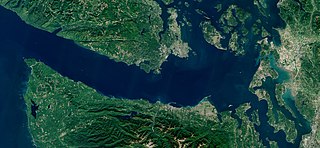
The Strait of Juan de Fuca is a body of water about 96 miles long that is the Salish Sea's main outlet to the Pacific Ocean. The international boundary between Canada and the United States runs down the centre of the Strait.
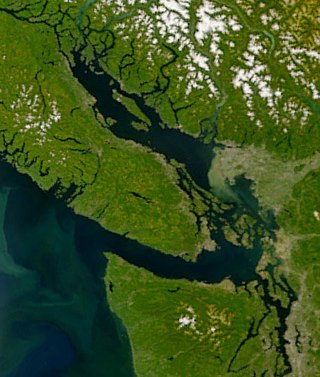
The Strait of Georgia or the Georgia Strait is an arm of the Salish Sea between Vancouver Island and the extreme southwestern mainland coast of British Columbia, Canada and the extreme northwestern mainland coast of Washington, United States. It is approximately 240 kilometres (150 mi) long and varies in width from 20 to 58 kilometres. Along with the Strait of Juan de Fuca and Puget Sound, it is a constituent part of the Salish Sea.

The following is an alphabetical list of articles related to the Canadian province of British Columbia.
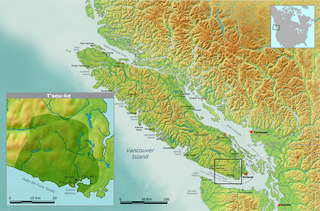
The T'sou-ke Nation of the Coast Salish peoples, is a band government whose reserve community is located on Vancouver Island, in the province of British Columbia, Canada. In February 2013, the T'sou-ke Nation had 251 registered members, with two reserves around the Sooke Basin on the Strait of Juan de Fuca at the southern end of Vancouver Island, with a total area of 67 hectares. The T'Souk-e people are the namesake of the town of Sooke, British Columbia and its surrounding harbour and basin.
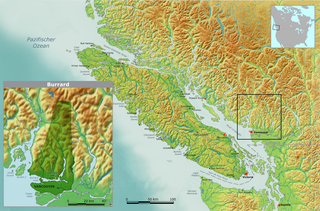
The Tsleil-Waututh Nation, formerly known as the Burrard Indian Band or Burrard Inlet Indian Band, is a First Nations band government in the Canadian province of British Columbia. The Tsleil-Waututh Nation ("TWN") are Coast Salish peoples who speak hən̓q̓əmin̓əm̓, the Downriver dialect of the Halkomelem language, and are closely related to but politically and culturally separate from the nearby nations of the Squamish and xʷməθkʷəy̓əm (Musqueam), with whose traditional territories some claims overlap.

The Musqueam Indian Band is a First Nations band government in the Canadian province of British Columbia. It is the only First Nations band whose reserve community lies within the boundaries of the City of Vancouver.

The Salish Sea is a marginal sea of the Pacific Ocean located in the Canadian province of British Columbia and the U.S. state of Washington. It includes the Strait of Georgia, the Strait of Juan de Fuca, Puget Sound, and an intricate network of connecting channels and adjoining waterways.
Naut’sa mawt Tribal Council is a First Nations Tribal Council located in British Columbia, Canada, with offices in Tsawwassen and Nanaimo. NmTC advises and assists its 11-member Nations in the areas of Community Planning, Economic Development, Financial Management, Governance and Technical Services NmTC is also actively involved in fostering dialogue and understanding between its members and their neighbouring communities.

The Tsawwassen First Nation is a First Nations government whose lands are located in the Greater Vancouver area of the Lower Mainland of British Columbia, Canada, close to the South Arm of the Fraser River and just north of the international boundary with the United States at Point Roberts, Washington. Tsawwassen First Nation lists its membership at 491 people, nearly half of whom live on the lands.

The Halalt First Nation is a First Nations tribe located on a reservation near Chemainus in southeastern Vancouver Island, British Columbia, Canada. The historical territory of the Halalt people is the lower Chemainus River Valley and Willy Island, which is offshore from today's town of Chemainus.

The Homalco First Nation is a First Nations government located in Bute Inlet near the upper Sunshine Coast of British Columbia, Canada. The Homalco are also known, with their neighbours the Sliammon and Klahoose and the K'ómoks of nearby parts of Vancouver Island, as the Mainland Comox. Their ancestral tongue is the Comox language.
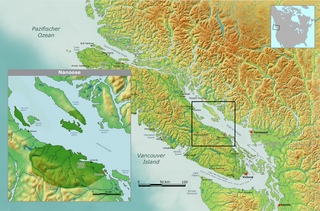
The Nanoose First Nation, also known the Snaw-naw-as First Nation, is a First Nations government located on central Vancouver Island in southwestern British Columbia, Canada, in the vicinity of the community of Nanoose Bay. They are Coast Salish people, and one of the most northern tribes on the east side of Vancouver Island. They speak Hul’q’umi’num’, which is 1 of 3 branches of the Halkomelem dialect spoken from Nanoose to Oregon.

The Tla'amin First Nation, formerly Sliammon Indian Band or Sliammon First Nation, is a First Nations self governing nation whose lands and traditional territories are located on the upper Sunshine Coast in southwestern British Columbia, Canada. The Tla'amin are closely related to the Klahoose and Homalco peoples and have shared their adjoining territories; formerly all three as well as K'omoks were grouped collectively as the Mainland Comox due to their shared language. They have been part of the Coast Salish indigenous peoples of the western coast of Canada since ancient times.

The Lekwungen or Lekungen nation are an Indigenous North American Coast Salish people who reside on southeastern Vancouver Island, British Columbia in the Greater Victoria area. Their government is the Songhees First Nation, a member of the Te'mexw Treaty Association and the Naut'sa Mawt Tribal Council. Their traditional language is Lekwungen, a dialect of the North Straits Salish language.
The Songhees First Nation is a First Nations government that represents the Songhees, or Lekwungen people. They are located around Victoria, British Columbia on southern Vancouver Island, British Columbia, Canada.

The ƛoʔos Klahoose are one of the three groups comprising the ʔayʔaǰuθəm Tla'Amin or Mainland Comox. The other two divisions of this once-populous group are the χʷɛmaɬku Homalco and Sliammon. The Klahoose, Homalco and Sliammon are, according to oral tradition, the descendants of the survivors of the Great Flood. The three groups were split by colonialism into different band councils but united historically as the Tla A'min, known as the Mainland Comox, and K’ómoks, the larger grouping of the Comox people, also known as the Island Comox and before the merger with the Laich-kwil-tach culture. Historically both groups are a subgroup of the Coast Salish though the K’ómoks name is from, and their language today, is the Lik'wala dialect of Kwak'wala. The ancestral tongue is the Comox language, though the Sahtloot/Island dialect is extinct.
The Chemainus River is located on southern Vancouver Island, British Columbia, Canada. Its source is in the Vancouver Island Ranges, and it flows eastwards to the Strait of Georgia near the town of Chemainus, British Columbia. The valley that surrounds the river additionally includes the communities of Crofton and Westholme as well as the Halalt First Nation Reserve and several smaller reserves. Located on one of the largest islands at the mouth of the river, an old now-deserted village called Xulel-thw stands on the northeast corner; Coast Salish peoples lived there and in other now-deserted villages in the area, constantly moving throughout history.
The K'ómoks First Nation, also known as the Comox Indian Band, is the band government of the Island Comox or K'ómoks people of Vancouver Island, British Columbia, Canada. Closely allied to the Cape Mudge and Campbell River First Nations, historically they were a Coast Salish people since integrated into Kwakwaka'wakw society. Originally part of the Laich-kwil-tach Council of Chiefs, which is a treaty society, they are now negotiating independently in the BC Treaty Process. They remain a member government of the Kwakiutl District Council.
Ladysmith Harbour, originally Oyster Harbour, is a harbour adjoining the Town of Ladysmith on Vancouver Island, British Columbia. The Ladysmith area was originally known as Oyster Harbour when it came into use as a coaling port for the Dunsmuir-owned mine at Extension.













